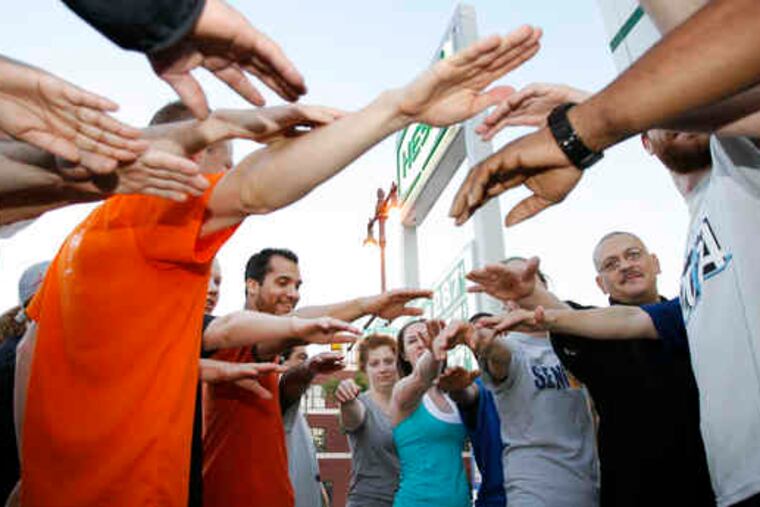For three years, running the homeless to success
He'd had only two hours of sleep, but it didn't matter: Ranald Lindsey woke up at 5 a.m. to run.

He'd had only two hours of sleep, but it didn't matter: Ranald Lindsey woke up at 5 a.m. to run.
In nine months, he'd gone from living in a homeless shelter to having his own apartment; from being unemployed to having a job as a cook; from huffing through a mile jog to completing a half-marathon.
And it all started, he said, because he runs.
"It opens my mind and makes me conscious of what I need to do," said Lindsey, 35. "Anybody can do it. It just takes that first step."
In 2007, a North Dakota transplant named Anne Mahlum came up with an unusual way of helping the city's homeless population: She would start a running club for them, encouraging self-sufficiency while promoting good health.
Since then, Back on My Feet and its unlikely premise have exploded. The Philadelphia-based nonprofit has already expanded to Baltimore, Boston and Washington, D.C. A Chicago chapter is expected to open before year's end.
The organization marks its third anniversary this month and will soon announce its 2011 expansion plans, which include reaching into five more cities. That growth rate far exceeds anything Mahlum imagined when she first asked a few homeless men to join her on her daily run.
"We needed time to learn," Mahlum said. "Now we can take what we've built to all these great cities."
What's been built is more than a running club, although attending the thrice-weekly 5:35 a.m. runs is important. Participants in Back on My Feet are rewarded for their commitment to the exercise and encouraged to transfer it to other areas of their lives. That could mean earning a GED or finding a job or moving out of the shelter and into a personal home.
Back on My Feet helps with financial assistance and, perhaps more important, emotional support. A recent run began with rounds of hugs and ended with a football-style huddle and the participants yelling, "Inspire! Strive! Endure! Achieve!"
"These people encourage you. They don't view you differently because of your past," said Antonio LaBoy, 49, as he looked around at the 40 people gathered before dawn to run together. "I look and I see unity of the group. I see friendship. These people are my friends."
LaBoy was there even though he wasn't running that day. He'd walked over to the South Philadelphia meeting spot a few blocks from the shelter where he lives to wish everyone a good run.
He couldn't join them because he now has a job as a parking attendant. A lot has changed for LaBoy since September, when- unemployed and feeling hopeless - he began running with Back on My Feet.
"It's a perfect name for this organization," he said. "Look at me. I'm going to work."
Jeremy Jordan, an assistant professor at Temple University's School of Tourism and Hospitality Management, and his students have spent the past year studying the organization and have found that the more connected participants are to the program, the more positive changes occur in other areas of their lives.
"It's definitely working," Jordan said. "When you think of this population, one of the challenges is keeping them engaged in any type of program that is longitudinal in nature."
Most participants complete the program - that is, moving from a shelter to independent living - within six to nine months. After they achieve that goal, Back on My Feet encourages them to set others, like saving money for a car or vacation or advancing at work or even running farther and farther. Mahlum said they've learned the hard way that continued goal-setting is key to continued success.
She said one runner "had a relapse and ended up back in a shelter. He got into the grind of, 'This is it? I go to work. I come home. This is what I'm working for?' "
While it may seem like an odd idea - getting the homeless to run as a way of helping them gain stability - the premise of engaging people and forming a relationship with them before encouraging them to better themselves is fairly basic, said Neil Donovan, executive director of the National Coalition for the Homeless.
"A lot of times people do it through recovery or some other form of self actualization, then they use the energy from that relationship to launch themselves out of homelessness into housing," Donovan said. "I think it's very effective. I think we really need a whole menu of ideas in order to solve the problem of homelessness."
Frederick Williams, 40, was living in 30th Street Station when he learned about Back on My Feet. Moving into a shelter, he then joined the program, running two miles straight on his first outing.
Almost a year later, Williams is running half-marathons. Although still living in a shelter, he has a job in a suburban bakery. His commute via bus and train can be an hour long, but he doesn't mind. He clears his mind when he moves fleet-footed through the streets.
"Everybody should run," Williams said. "Just run."